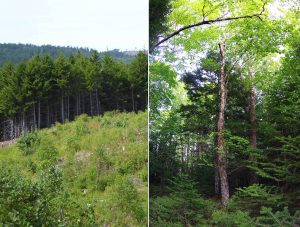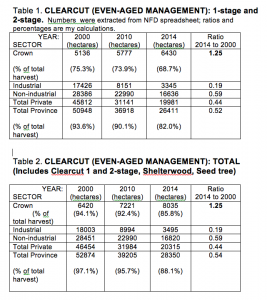The answer depends on who you ask.

Two woodlots in Nova Scotia. Definitely clearcut (left foreground) and definitely not-clearcut (right), but what about the even-aged, conifer dominated stand in the background at left – was it produced by a “clearcut” or a “partial cut”? Does it matter?
Formally, NSDNR defines a clearcut as “a forest harvest where less than 60% of the area is sufficiently occupied with trees taller than 1.3 meters”.
That may be a bit difficult to grasp, but NSDNR provides photographs of recently cut stands that qualify and don’t qualify as clearcuts.
The PTAs (Pre-Treatment Assessments) that are conducted on Crown lands proposed for harvest list the following Prescription options:
– CC=clearcut,
– OR=Overstory removal
– CT=Commercial thinning
– SH=Selection harvest
– SW=Shelterwood harvest
– ST=Seed tree
– VT= Variable retention
Under this system, CC, OR and ST are classified as “clearcuts”, while SW, VT, CT and SH are are classified as “Partial Cuts”.
In the The National Forestry Database (NFD), on the other hand, all harvests that qualify as even-aged management are classified as clearcuts; in the NFD, there are three categories of Clearcut (even-aged management):
– clearcut- 1-stage and 2-stage,
– Shelterwood
– Seed tree
In both systems, Selection Harvests, and Commercial Thinning are not counted as clearcuts. I assume “Variable retention” in the NSDNR system is considered a Partial Cut; there is no corresponding classification in the NFD system.
I am grateful to Ryan MacIntryre of NSDNR for quick feedback after my making this post for correcting my impression that under the NSDNR system all except CC were classified as Partial Cuts. He also commented that “Shelterwoods are classified as partial harvest because the timber removal during a shelterwood is typically ~30% of the standing timber, leaving ~70% intact after the harvest. The goal of a shelterwood is to open the canopy to allow light to the forest floor, promoting growth of natural regeneration of shade tolerant tree species, such as red spruce or hemlock.”
I would describe the Nova Scotia definition as a “restricted definition of clearcuts”, and the NFD definition, a “broader definition”. Which definition is used matters. It matters percentage-wise, it matters in regard to what it does and it matters in regard to how the public understands what is a clearcut and what is not a clearcut.
So let’s look at some numbers and percentages based on National Forest Database (NFD) info.
By the restricted definition (but including “2-stage clearcuts”), clearcutting was 68.7% of total cutting on Crown land in Nova Scotia 2014. By the broader definition, it was 85.8%. Most of the difference was made up by shelterwood cuts.
On what it does – here’s my interpretation of the two numbers. 68.7% of total cutting on Crown land in 2014 involved removal of most protective cover; 85.8-68.7=17.1% involved “gentler clearcuts” – mostly shelterwood cuts – with less loss of protective cover during the period the next generation of trees gets a start. The “gentler clearcuts” provide a better environment for seedling establishment, are more favourable for shade-tolerant species, and reduce erosion and loss of nutrients, but are more expensive, require more skilled operators and may not be suitable on some sites because of high windthrow hazard. Both types (85.8% in total on Crown land in 2014) create or maintain even-aged forests which will likely be clearcut (broad definition) the next time around, although it’s possible that a portion of the gentler clearcuts is intended to transition to a multiage structure with more shade intolerant species. (re: Intolerant Hardwood Management Guide
On public understanding of what is a clearcut and what is not a clearcut
When many Nova Scotians expressed a desire for less clearcutting in the Citizen Engagement phase for development of the Natural Resources Strategy, I am pretty sure most of them were thinking in terms of the broad definition. They wanted to see more of the natural, mixed, multi-aged Acadian forest in Nova Scotia and less of the even aged industrial forests maintained by clearcutting of all sorts.
——
This blog post is the 2nd of three in a series that explore the apparent contradiction between public concern about clearcutting in Nova Scotia and NSDNR reassurances that clearcutting has been reduced and that “all harvest treatments are aligned with the nature-based requirements of Nova Scotia’s lands”.
The first post (Jan 22, 2017):
Has clearcutting on Crown land in Nova Scotia increased or decreased?The second post (Jan 23, 2017):
What’s a clearcut and what’s not a clearcut in Nova Scotia?The third post (Jan 23, 2017):
How much forestry in Nova Scotia maintains mixed, multi-aged Acadian forest?

